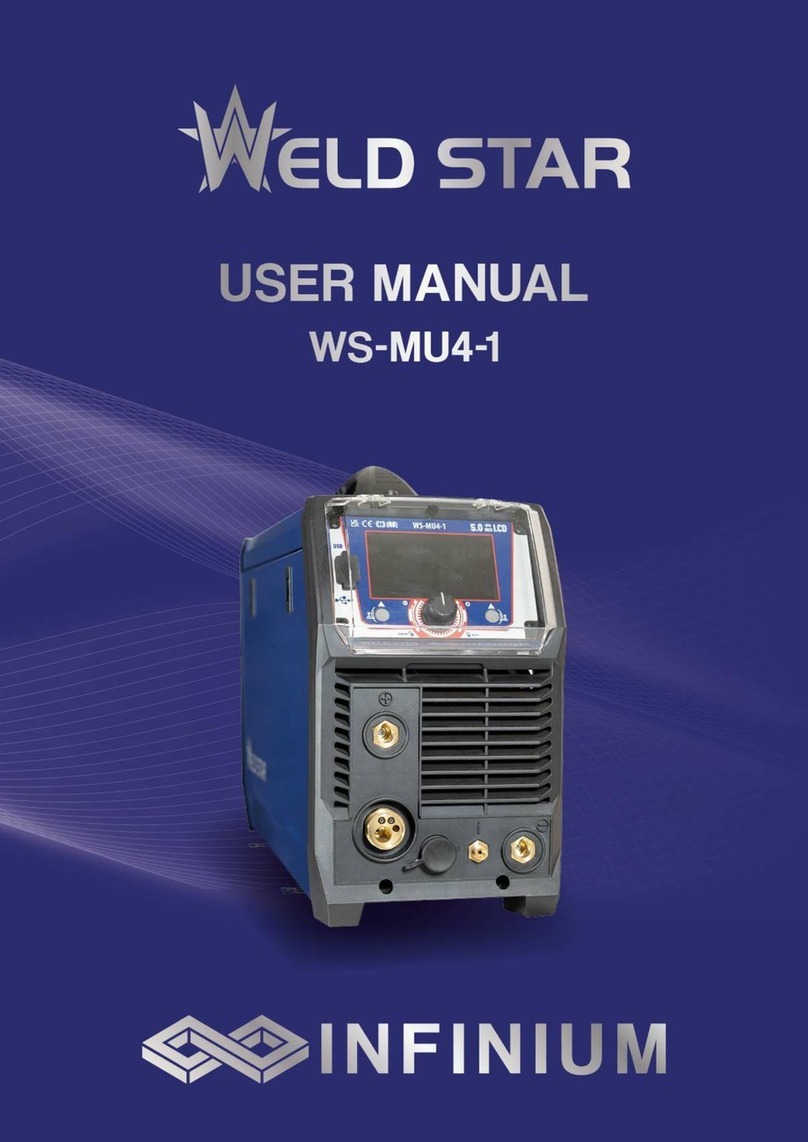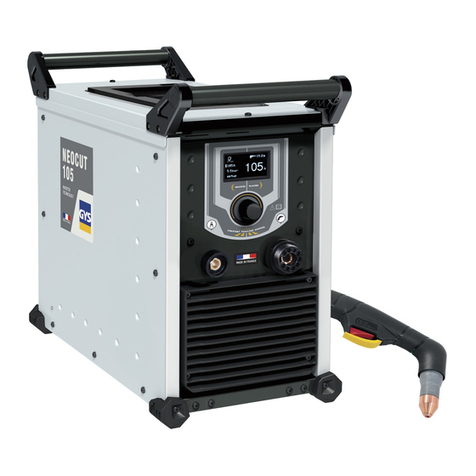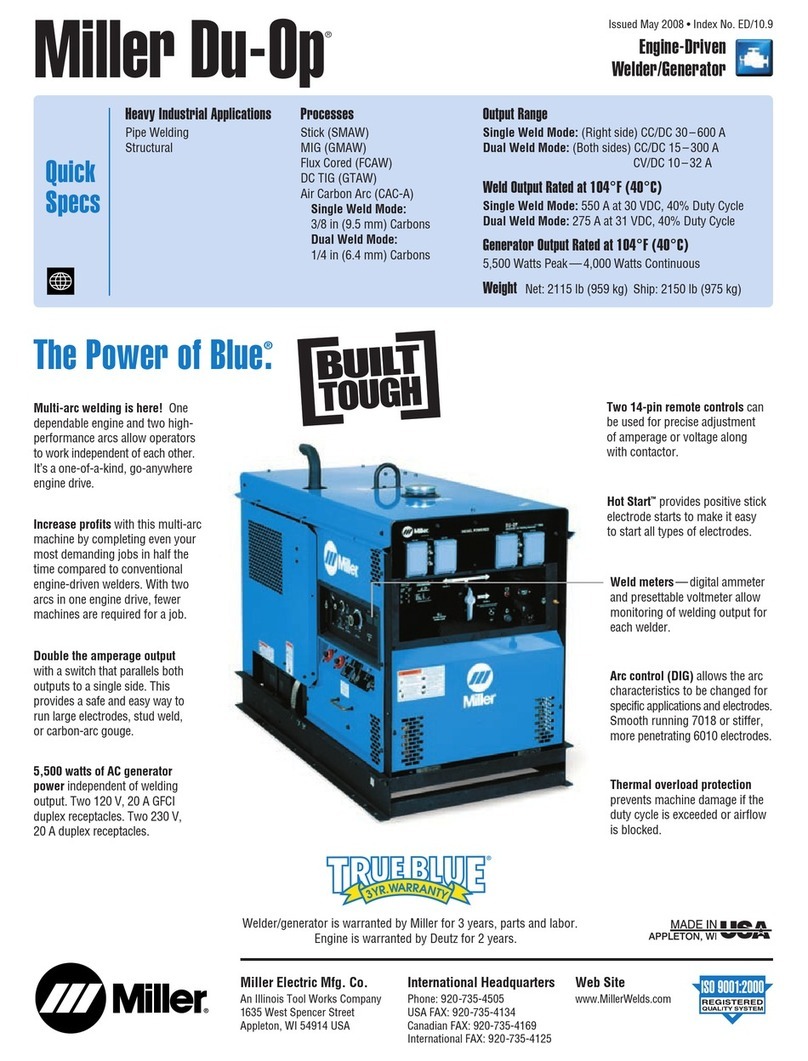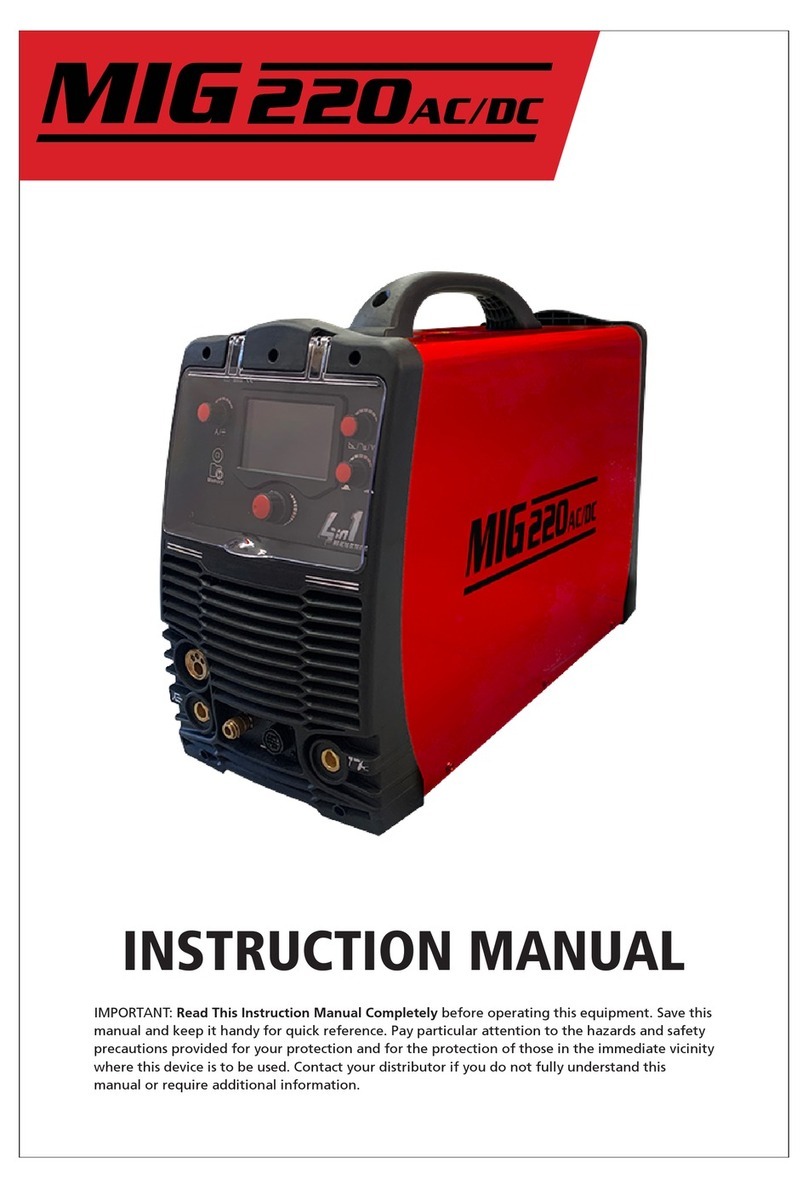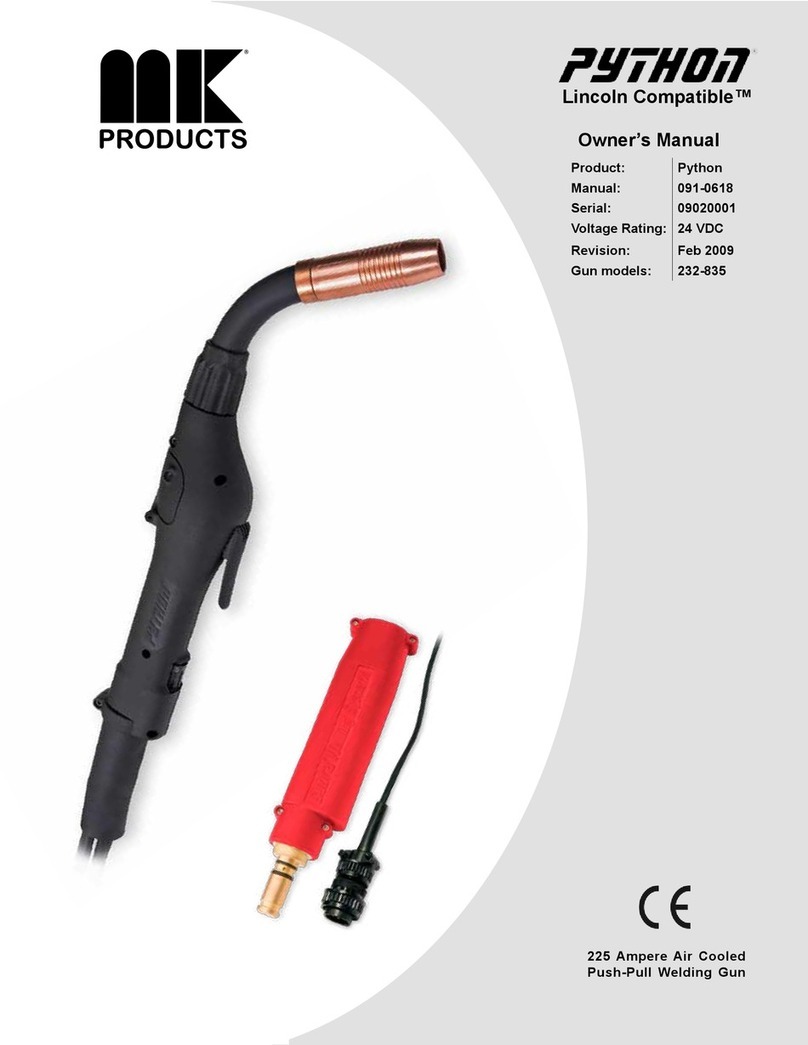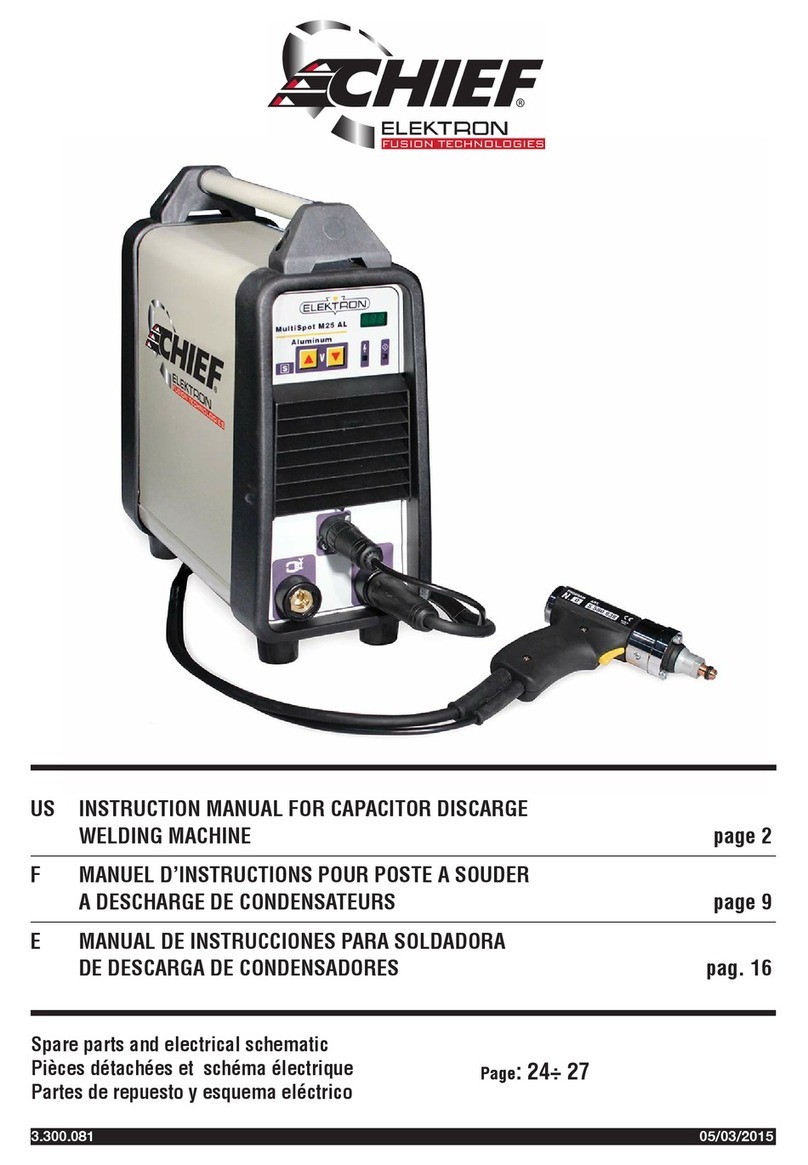Infinium Weld Star WS-PC40-230 User manual


2
Introducon to your new product
Thank you for selecng this Weld Star Innium product.
This product manual has been designed to ensure that you get the most from your new Weld Star
product. Please ensure that you are fully conversant with the informaon provided paying parcular
aenon to the safety precauons. The informaon will help protect yourself and others against the
potenal hazards that you may come across.
Please ensure that you carry out daily and periodic maintenance checks to ensure years of reliable and
trouble free operaon.
Please call your Weld Star distributor in the unlikely event of a problem occurring.
Please record below the details from your new Weld Star product as these may be required for warranty
purposes to ensure you give the correct informaon should you require assistance or spare parts.
Date purchased ________________________________________
Purchased from ________________________________________
Model name ________________________________________
Serial number ________________________________________
(The serial number is normally located on the product packaging, top or underside of the machine)
Disclaimer
Whilst every eort has been made to ensure that the informaon contained within this manual is
complete and accurate, no liability can be accepted for any errors or omissions.
Please note:
Products are subject to connual development and may be subject to change without noce.
www.weldstar.uk
No part of this manual may be copied or reproduced by any means without the wrien permission of
Wilkinson Star Limited.

3
CONTENTS
Page
Your New Product 2
Index 3
Safety Instrucons 4
General electrical and operang safety 5
PPE and Welding processes lens shade selector guide 6
Fume and welding gases and re risks 7
The working environment, Magnec elds and cylinder safety 8
Noise and re awareness, hot parts and RF/LF declaraons 9
Materials and their disposal 9
Package Contents and Unpacking 9
Product Overview 10
Product details and applicaon 11
Technical Specicaons 12
Descripon of Controls 13
What is Plasma? 15
Installaon 16
Operaon - User Setup 17
Operaon - Modes of Cung 21
Operaon - Cung Techniques 24
Plasma Hand Torch IPT-40 Consumable breakdown (WS-PC40-230) 27
Plasma Cung Problems 28
Troubleshoong 29
Maintenance 30
Plasma Torch Plug and Socket Wiring Diagram 30
WEEE Disposal 31
RoHS Compliance Declaraon 31
UKCA Declaraon of Conformity 31
EC Declaraon of Conformity 32
Statement of Warranty 33
Notes 34
Weld Star Contact Details 36

4
SAFETY INSTRUCTIONS
These general safety norms cover both arc welding machines and plasma cung
machines unless otherwise noted. The user is responsible for installing and operang
the equipment in accordance with the enclosed instrucons.
It is important that users of this equipment protect themselves and others from harm, or even death.
The equipment must only be used for the purpose it was designed for. Using it in any other way could
result in damage or injury and in breach of the safety rules.
Only suitably trained and competent persons should operate the equipment.
Pacemaker wearers should consult their doctor prior to using this equipment.
PPE and workplace safety equipment must be compable for the applicaon of the work involved.
Always carry out a risk assessment before carrying out any welding or cung acvity.
General electrical safety
The equipment should be installed by a qualied person and in accordance with current
standards in operaon.
It is the users responsibility to ensure that the equipment is connected to a suitable power
supply. Consult your ulity supplier if required.
Do not use the equipment with the covers removed. Do not touch live electrical parts or parts
which are electrically charged. Turn o all equipment when not in use.
In the case of abnormal behaviour of the equipment, the equipment should be checked by a suitably
qualied service engineer.
If earth bonding of the work piece is required, bond it directly with a separate cable with a current
carrying capacity capable of carrying the maximum capacity of the machine current.
Cables (both primary supply and welding) should be regularly checked for damage and overheang.
Never use worn, damaged, under sized or poorly jointed cables.
Insulate yourself from work and earth using dry insulang mats or covers big enough to prevent any
physical contact.
Never touch the electrode if you are in contact with the work piece return.
Do not wrap cables over your body.
Ensure that you take addional safety precauons when you are welding in electrically hazardous
condions such as damp environments, wearing wet clothing and metal structures.
Try to avoid welding in cramped or restricted posions.
Ensure that the equipment is well maintained. Repair or replace damaged or defecve parts immediately.
Carry out any regular maintenance in accordance with the manufacturers instrucons.
The EMC classicaon of this product is class A in accordance with electromagnec compability
standards CISPR 11 and IEC 60974-10 and therefore the product is designed to be used in industrial
environments only.
WARNING: This class A equipment is not intended for use in residenal locaons where the electrical
power is provided by a public low-voltage supply system. In those locaons it may be dicult to ensure
the electromagnec compability due to conducted and radiated disturbances.
General operang safety
Never carry the equipment or suspend it by the carrying strap or handles during welding.
Never pull or li the machine by the welding torch or other cables.
Always use the correct li points or handles. Always use the transport under gear as
recommended by the manufacturer.
Never li a machine with the gas cylinder mounted on it.
If the operang environment is classied as dangerous, only use S-marked welding equipment with a safe
idle voltage level. Such environments may be for example: humid, hot or restricted accessibility spaces.

5
SAFETY INSTRUCTIONS
Use of Personal Protecve Equipment (PPE)
Welding arc rays from all welding and cung processes can produce intense, visible
and invisible (ultraviolet and infrared) rays that can burn eyes and skin.
• Wear an approved welding helmet ed with an appropriate
shade of lter lens to protect your face and eyes when
welding, cung or watching.
• Wear approved safety glasses with side shields under your
helmet.
• Never use any equipment that is damaged, broken or faulty.
• Always ensure there are adequate protecve screens or
barriers to protect others from ash, glare and sparks from
the welding and cung area.
• Ensure that there are adequate warnings that welding or
cung is taking place.
• Wear suitable protecve ame resistant clothing, gloves and
footwear.
• Ensure adequate extracon and venlaon is in place prior to
welding and cung to protect users and all workers nearby.
• Check and be sure the area is safe and clear of ammable material before carrying out any welding
or cung.
Some welding and cung operaons may produce noise. Wear safety ear protecon to protect your
hearing if the ambient noise level exceeds the local allowable limit (e.g: 85 dB).
Welding and Cung Lens Shade Selector Guide
Current MMA
Electrodes
MIG
Light Alloys
MIG
Heavy Metals MAG TIG Plasma
Cung
Plasma
Welding
Air Arc
Gouging Current
10 8
10 10 10
9
11
10
10
10
15 15
20
9
20
30 10 11
30
40 40
60 10 11
60
80
12
80
100
11 11
11 100
125
11 12
125
150 12
13
150
175
12
175
200
12
12
12 13
13 11 200
225 225
250 12 250
275 13
14 14
275
300
13
13 300
350
13 14 13 14
350
400 14 400
450 450
500 14 15 14 15 15 500

6
SAFETY INSTRUCTIONS
Safety against fumes and welding gases
The HSE have idened welders as being an ‘at risk’ group for occupaonal diseases arising
from exposure to dusts, gases, vapours and welding fumes. The main idened health eects
are pneumonia, asthma, chronic obstrucve pulmonary disease (COPD), lung and kidney
cancer, metal fume fever (MFF) and lung funcon changes.
During welding and hot cung ‘hot work’ operaons, fumes are produced which are
collecvely known as welding fume. Depending upon the type of welding process being performed, the
resultant fume generated is a complex and highly variable mixture of gases and parculates.
Regardless of the length of welding being carried out, all welding fume, including mild steel welding
requires suitable engineering controls to be in place which is
usually Local Exhaust Venlaon (LEV) extracon to reduce the
exposure to welding fume indoors and where LEV does not
adequately control exposure it should also be enhanced by
using suitable respiratory protecve equipment (RPE) to assist
with protecng against residual fume.
When welding outdoors appropriate RPE should be used.
Prior to undertaking any welding tasks an appropriate risk
assessment should be carried out to ensure expected control
measures are in place.
Locate the equipment in a well-venlated posion and keep your head out of the welding fume.
Do not breathe in the welding fume.
Ensure the welding zone is well-venlated and provision should be made for suitable local fume
extracon system to be in place.
If venlaon is poor, wear an approved airfed welding helmet or respirator.
Read and understand the Material Safety Data Sheets (MSDS’s) and the manufacturer’s instrucons for
metals, consumable, coangs, cleaners and de-greasers.
Do not weld in locaons near any de-greasing, cleaning or spraying operaons.
Be aware that heat and rays of the arc can react with vapours to form highly toxic and irritang gases.
For further informaon please refer to the HSE website www.hse.gov.uk for related documentaon.
Precauons against re and explosion
Avoid causing res due to sparks and hot waste or molten metal.
Ensure that appropriate re safety devices are available near the welding and cung area.
Remove all ammable and combusble materials from the welding, cung and surrounding
areas.
Do not weld or cut fuel and lubricant containers, even if empty. These must be carefully
cleaned before they can be welded or cut.
Always allow the welded or cut material to cool before touching it or
placing it in contact with combusble or ammable material.
Do not work in atmospheres with high concentraons of combusble
fumes, ammable gases and dust.
Always check the work area half an hour aer cung to make sure that
no res have begun.
Take care to avoid accidental contact of the torch electrode to metal
objects, as this could cause arcs, explosion, overheang or re.
Know and understand your re exnguishers
An example of personal fume protecon

7
SAFETY INSTRUCTIONS
The working environment
Ensure the machine is mounted in a safe and stable posion allowing for cooling air circulaon.
Do not operate equipment in an environment outside the laid down operang parameters.
The welding power source is not suitable for use in rain or snow.
Always store the machine in a clean, dry space.
Ensure the equipment is kept clean from dust build up.
Always use the machine in an upright posion.
Protecon from moving parts
When the machine is in operaon keep away from moving parts such as motors and fans.
Moving parts, such as the fan, may cut ngers and hands and snag garments.
Protecons and coverings may be removed for maintenance and managed only by qualied
personnel aer rst disconnecng the power supply cable.
Replace the coverings and protecons and close all doors when the intervenon is nished and before
starng the equipment.
Take care to avoid geng ngers trapped when loading and feeding wire during set up and operaon.
When feeding wire be careful to avoid poinng it at other people or towards your body.
Always ensure machine covers and protecve devices are in operaon.
Risks due to magnec elds
The magnec elds created by high currents may aect the operaon of pacemakers or
electronically controlled medical equipment.
Wearers of vital electronic equipment should consult their physician before beginning any arc
welding, cung, gouging or spot welding operaons.
Do not go near welding equipment with any sensive electronic equipment as the magnec
elds may cause damage.
Keep the torch cable and work return cable as close to each other as possible throughout their length.
This can help minimise your exposure to harmful magnec elds.
Do not wrap the cables around the body.
Handling of compressed gas cylinders and regulators
Mishandling gas cylinders can lead to rupture and the release of high pressure gas.
Always check the gas cylinder is the correct type for the welding to be carried out.
Always store and use cylinders in an upright and secure posion.
All cylinders and pressure regulators used in welding operaons should be handled with care.
Never allow the electrode, electrode holder or any other electrically “hot” parts to touch a
cylinder.
Keep your head and face away from the cylinder valve outlet when opening the cylinder valve.
Always secure the cylinder safely and never move with regulator and hoses connected.
Use a suitable trolley for moving cylinders.
Regularly check all connecons and joints for leaks.
Full and empty cylinders should be stored separately.
Never deface or alter any cylinder

8
SAFETY INSTRUCTIONS
Fire awareness
The cung and welding process can cause serious risks of re or explosion.
Cung or welding sealed containers, tanks, drums or pipes can cause explosions.
Sparks from the welding or cung process can cause res and burns.
Check and risk assess the area is safe before doing any cung or welding.
Venlate all ammable or explosive vapour from the workplace.
Remove any and all ammable materials away from the working area. If necessary, cover ammable
materials or containers with approved covers (following manufacturers instrucons) if unable to
remove from the immediate area.
Do not cut or weld where the atmosphere may contain ammable dust, gas or liquid vapour.
Always have the appropriate re exnguisher nearby and know how to use it.
Hot parts
Always be aware that material being cut or welded will get very hot and hold that heat for a
considerably long me which will cause severe burns if the appropriate PPE is not worn.
Do not touch hot material or parts with bare hands.
Always allow for a cooling down period before working on material recently cut or welded.
Use the appropriate insulated welding gloves and clothing to handle hot parts to prevent burns.
Noise awareness
The cung and welding process can generate noise that can cause permanent damage to your
hearing. Noise from cung and welding equipment can damage hearing.
Always protect your ears from noise and wear approved and appropriate ear protecon if
noise levels are high.
Consult with your local specialist if you are unsure how to test for noise levels.
RF Declaraon
Equipment that complies with direcve 2014/30/EU concerning electromagnec compability
(EMC) and the technical requirements of EN60974-10 is designed for use in industrial buildings
and not for domesc use where electricity is provided via the low voltage public distribuon
system.
Dicules may arise in assuring class A electromagnec compability for systems installed in domesc
locaons due to conducted and radiated emissions.
In the case of electromagnec problems, it is the responsibility of the user to resolve the situaon.
It may be necessary to shield the equipment and t suitable lters on the mains supply.
LF Declaraon
Consult the data plate on the equipment for the power supply requirements.
Due to the elevated absorbance of the primary current from the power supply network, high
power systems aect the quality of power provided by the network. Consequently, connecon
restricons or maximum impedance requirements permied by the network at the public network
connecon point must be applied to these systems.
In this case, the installer or the user is responsible for ensuring the equipment can be connected,
consulng the electricity provider if necessary.

9
SAFETY INSTRUCTIONS
Materials and their disposal
Welding equipment is manufactured with BSI published standards meeng CE requirements for
materials which do not contain any toxic or poisonous materials dangerous to the operator.
Do not dispose of the equipment with normal waste. The European Direcve 2012/19/EU on
Waste Electrical and Electronic Equipment states that electrical equipment that has reached its end of
life must be collected separately and returned to an environmentally compable recycling facility for
disposal.
For more detailed informaon please refer to the HSE website www.hse.gov.uk
PACKAGE CONTENTS AND UNPACKING
Supplied within your new Weld Star Innium product package will be the following items with each
model. Use care when unpacking the contents and ensure all items are present and not damaged.
If damage is noted or items are missing, please contact the supplier in the rst instance and before
installing or using the product.
Record the product model, serial numbers and purchase date in the informaon secon found on the
inside front page of this operang manual.
Weld Star WS-PC40-230
PC-40-230 Plasma Power Source
4m IPT-40 Plasma Hand Torch
Air Regulator
Work Return Lead
PCL Air Fing
Operang Manual
Please Note: Package contents may vary depending on country locaon and package part number purchased.

10
PRODUCT OVERVIEW
The Weld Star Innium inverter plasma cung machine range with built-in compressor has been
designed as integrated portable cung machines which incorporate the most advanced IGBT inverter
technology.
Weld Star Plasma WS-PC40-230 Product Features:
• The WS-PC40-230 is a 230V compact, lightweight and portable inverter based plasma cung machine
with an in-built air compressor that oers excellent operator exibility.
• Advanced, high eciency plasma systems that oer exible portability along with smooth and precise
cung characteriscs that’s ideal when cung steel, stainless, copper, cast iron as well as aluminium.
• The Weld Star Innium plasma range oers the exibility of switching between the in-built
compressor or using your own workshop supplied compressed air.
• The Weld Star Plasma WS-PC40-230 oers a clean cut of 12mm and a severance cut of 16mm. *
• Auto pilot restart allows for faster restarng of the pilot arc which allows for uninterrupted cung
of grid or perforated type material.
• Plasma cung speeds can be up to 1.8 mes faster when compared with oxy acetylene cung.
• Advanced non HF pilot arc ignion via the supplied plasma cung torch.
• The single carry handle oers excellent portability when working or maneuvering when on site or in
the workshop.
• Well laid out, simple to use operator control panels.
• Generator friendly (with built-in AVR).
• Oponal circle cung guide kit available.
* Based on mild steel using workshop compressed air.

11
PRODUCT DETAILS AND APPLICATION
Advanced digital circuitry
In tradional machines, consistency and performance is oen governed by the tolerances of the
components used in manufacture and environmental condions such as temperature and humidity.
The Weld Star plasma cung machine range incorporate high end digital control technology which is
enhanced by being controlled with the latest soware.
These digital controlled plasma cung machines oer many improvements in funcon and performance
when compared with tradional (older) type plasma cung machines.
Having the latest PWM technology and high power IGBT components oers a greater level of stability
and reliability which ulmately give the operator a very stable DC output which is transferred to the
plasma cung torch to create the required plasma pilot and cung arc.
This inverter technology allows for modern machines to be smaller, lighter and more electrically ecient
than tradional type transformer machines along with excellent cung performance.
This high eciency technology provides switching frequencies which are outside the audible range.
Powerful cung performance
The Weld Star Innium plasma range of machines provides economical cung of metals using either the
in-built compressed air or workshop compressed air supply as the plasma gas source.
Cung speeds can be up to 1.8 mes faster when cung carbon steel compared with oxy-acetylene
cung.
Plasma machines can cut steel, stainless steel, copper, cast iron and aluminium easily and quickly.
The plasma pilot arc is eciently started when using non HF arc ignion technology.
There is a gas post ow funcon that assists in cooling the plasma torch aer cung nishes.
Simple operaon, high cung speeds and smooth cung surface make the plasma process an excellent
cung method.
Product features
The Weld Star Plasma Innium range cung current can be accurately set by the operator via the
control panel which allows the machine to be set and then cut material of dierent thicknesses easily
and quickly.
Low cung amperage is used when cung thin plate and when required to cut thicker material then
increasing the cung current will oer exibility to the operator in achieving excellent cut quality which
also oers energy savings.
Further features include, under and over under (input) voltage protecon, thermal overheang, air
purge and the ability to cung grid/perforated type material.
Applicaon
The non-HF pilot arc circuitry of the plasma innium range combined with the plasma torch design oers
excellent starng pilot arc ignion and cung arc characteriscs which will cut through rusty and painted
material that oer excellent cut quality performance with ferrous and non ferrous materials which can
eecvely prolong the lifespan of the electrode and nozzle consumables of the plasma cung torch.
It can be widely used in various industries involving metal cung such as boiler, pressure vessel
manufacturing, chemical container manufacturing, power plant installaon, construcon industry,
metallurgy, chemical engineering, aerospace, automobile, engineering vehicles manufacturing,
construcon and many more.

12
TECHNICAL SPECIFICATIONS
* Based on mild steel and thickness rangs can vary depending on cung speed.
Please Note
Due to variaons in manufactured products all claimed performance rangs, capacies, measurements, dimensions and
weights quoted are approximate only. Achievable performance and rangs when in use can depend upon correct installaon,
applicaons and use along with regular maintenance and service.
Parameter Unit WS-PC40-230
Rated input voltage V230V AC ±15%
Rated input frequency Hz 50/60
Rated input power kVA 5.2
Rated input current Imax A22.6
Rated input current Ie A16
Cung current range A20 ~ 40
Rated output voltage V96
No load voltage V400
Rated duty cycle 40°C
%
40A@35%
36A@60%
30A@100%
Clean cut (Int/ext air) * mm 10/12
Severance cut (Int/ext air) * mm 14/16
Minimum air pressure (external) psi 5 Bar (73psi)
Maximum air pressure (external) psi 6 Bar (87psi)
Minimum gas ow (external air) CFM
Ltr/min
4.5CFM
127 Ltr/min
Eciency %85
Idle state Power W11
Power factor cosφ0.99
Plasma torch - 4m IPT-40
Standard - EN60974-1
Protecon class IP IP23 S
Insulaon class - H
Arc ignion - Non HF
Noise Db <110
Operang temperature °C -10 ~ +40
Storage temperature °C -25 ~ +55
Overall size (HxWxD) mm 610 x 215 x 420
Weight Kg 21
Circle cung guide kit - Pt No 51866

13
DESCRIPTION OF CONTROLS
Front view Weld Star Plasma WS-PC40-230
1. Carry handle
2. Control panel indicators
3. Machine ON/OFF power switch
4. Internal/external air selector switch
5. Current control dial
6. Control selector switch
7. Torch connector, the plasma torch connecon
(see page 17 for ng instrucons)
8. Cooling air vent
9. N/A
10. Work return connector
(10/25mm dinse socket)
Rear view Weld Star Plasma WS-PC40-230
11. Carry handle
12. Air pressure regulator adjustment knob
13. Air pressure gauge
14. Air pressure inlet
(from workshop compressor)
15. Mains input cable
16. Air pressure regulator lter
17. Air vent
18. Air pressure regulator drain

14
CONTROLS
Control panel view - Weld Star Plasma WS-PC40-230
Number Symbol Funcon
19 - Mains power ON/OFF switch. Use this switch to turn the machine on and o.
Turn o and disconnect the machine from the mains supply when not in use.
20 Power indicator: This LED will illuminate when the machine is connected to the
mains power and the ON/OFF switch is turned ON.
21
Power or overload error LED: This LED will light up when over-voltage, over-current
or overheang (exceeding duty cycle) is experienced and the unit enters protecon
mode.
When this LED is lit, the output will be disabled unl the system overload has
either reduced or has been removed and only then will the indicator LED go out.
22
Plasma torch error LED: This LED will light up when an error or fault has been
detected with either the plasma torch or air supply.
Cung output will be disabled unl the fault clears.
A ashing LED will mean that the torch shield cap is not ed correctly.
A connuous LED will mean either a missing consumable, torch damage or
insucient air pressure supply to the machine/plasma torch.
23 Cung output LED: This LED will be lit when the output power has been acvated
and will remain lit while cung.
24 Current control dial: This dial allows the user to set the required output current
demand which is shown via the sengs alongside the dial of 20 - 40amps.
25 This selecon switch allows the user to switch between opons (numbers) 26, 27
and 28
26 Air purge switch: This switch allows the user to acvate gas ow to allow the gas
ow to be checked and set.
27
Normal cung LED: When this opon is selected the user is in standard cung
mode i.e. for use with solid workpieces.
28
Grid/Perforated metal cung LED: When this cung opon is selected the user
can cut grid/perforated material without having to remove the nger from the
torch trigger as the pilot arc will automacally restart.
29 - Internal/external air switch: Allows the user to select either the internal air
compressor or to select to use ‘external’ workshop supplied compressed air.

15
WHAT IS PLASMA?
• Plasma is commonly described as the fourth state of maer (i.e. solid, liquid, gas then plasma).
• If you increase gas to an extremely high temperature you get the fourth state
plasma, the energy begins to break apart the gas molecules and the atoms
begin to split. Normal atoms are made up of protons and neutrons in the
nucleus surrounded by a cloud of electrons. In plasma, the electrons
separate from the nucleus. Once the energy of heat releases the
electrons from the atom, the electrons begin to move around quickly.
The electrons are negavely charged and they leave behind their
posively charged nuclei. These posively charged nuclei are known
as ions. When the fast-moving electrons collide with other electrons
and ions, they release vast amounts of energy. This energy is what gives
plasma its unique status and unbelievable cung power.
• Plasma is a gas which has been heated to an extremely high temperature and ionized so that it
becomes electrically conducve. An example of naturally occurring plasma is lightning.
• The plasma arc cung, gouging and welding processes uses plasma to transfer an electrical arc to
the work piece, the electrically conducve gas will transfer the energy from the plasma power source
through a plasma torch to the material being cut.
• The plasma arc cung process basics can be seen in the
illustraon. The basic principle is that the arc is formed
between the electrode and the work piece by forcing the
plasma gas and the electrical arc through a small orice
within the copper p. This will increase the speed and
temperature of the plasma exing the p.
• The temperature of the plasma is in excess of 15000°C
and the speed can approach that of sound. This plasma
gas ow in conjuncon with the high temperature
enables a deeply penetrang plasma jet to cut through
the work piece material and at the same me molten
material is blown away from the cut.
• The process diers from the oxy-fuel process in that the plasma process works by using the high
temperature arc to melt the metal to be cut. With the oxy-fuel process, the oxygen oxidises the metal
to be cut and the heat from the exothermic reacon melts the metal.
So, unlike the oxy-fuel process, the plasma process can be used to cut metals including those which
form protecve refractory oxides such as aluminium, stainless steel, non-ferrous alloys and cast iron.
• The output current (amps) of the power supply will determine the cung thickness and speed
capabilies of the plasma machine.
• While the primary goal of plasma arc cung is the separaon of metal, plasma arc gouging is used
to remove metals to a controlled depth and width.
• Plasma machines consist of a power supply, an arc starng circuit, a plasma torch and a compressed
air supply.
• Direct current (DC) straight polarity is used for plasma cung with the electrode being negave (-)
and the p/work piece being posive (+).

16
INSTALLATION
Before starng any welding acvity ensure that you have suitable eye protecon and
protecve clothing. Also take the necessary steps to protect any personnel within the
welding area.
Unpacking
Check the packaging for any signs of damage.
Carefully remove the machine and retain the packaging unl the installaon is complete.
Locaon
The machine should be located in a suitable posion and environment.
Care should be taken to avoid moisture, dust, steam, oil or corrosive gases.
Place on a secure level surface and ensure that there is adequate clearance around the machine to
ensure natural airow.
Input mains power connecon
Before connecng the machine you should ensure that the correct supply is available.
Details of the machine requirements can be found on the specicaon data plate of the machine or
within the technical parameters shown in the manual.
The equipment should be connected to the mains supply by a suitably qualied competent person.
Always ensure the equipment has a proper grounding in accordance with local standards.
Never connect the machine to the mains supply with the panels removed.
Input air connecon (if using workshop supplied compressed air)
• The Weld Star Plasma range of machines are only designed to be used with compressed air (DO NOT
USE OXYGEN or any other gas) and the compressor or air cylinder air requirements are as follows:
• Minimum air input: 5 Bar (75psi)
• Maximum air input: 7 Bar (87psi)
• Minimum air ow: 4.5CFM (120Ltr/min)
• Connect the compressed air with the supplied air hose and air ng to the machine via the inlet
connecon on the rear panel (max 8 Bar).
• The air regulator for the Weld Star plasma machine is mounted on the rear panel and is fully
adjustable. To adjust please see page 18 for further instrucons.
• Any moisture/water which has been collected by the air regulator will be drained by the auto drain
system of the in-built air regulator.
• Ensure your compressor oers only dry compressed air and is capable of delivering the volume of air
that is required to run your plasma cung machine to specicaon. We recommend minimum air
supply requirements of 120 Ltr/min @ 5 Bar (75psi).
• When using either a compressed air cylinder or a compressor ensure it is equipped with a suitably
ed high pressure regulator capable of reducing the pressure to the required amount.
Output connecons
Work return cable
Insert the cable plug of the work return lead
into the dinse socket on the front panel of
the welding machine and ghten it clockwise.
Please Note:
Check these power connecons daily to ensure they have
not become loose otherwise arcing may occur when used under load.
Generic library picture

17
OPERATION - USER SET UP
Before starng any welding acvity ensure that you have suitable eye protecon and
protecve clothing. Also take the necessary steps to protect any personnel within the
welding area.
Output connecons
Plasma torch
The IPT40 plasma torch supplied with your Weld Star machine
has the ‘euro style’ power/gas connecon (in this case the gas
used is compressed air), pilot cable and the torch switch pin
connecons.
The Weld Star plasma cung systems and torches incorporate a safety circuit to prevent
operator injury when changing consumables etc. This is a simple ring circuit that breaks
the electrical torch switching as soon as the retaining cap is removed prevenng machine
operaon. Without such protecon circuitry, as previously menoned, the open circuit
voltage could be as high as 350V DC at the torch head.
The torch head encompasses a full set of consumables as
shown right, these consumables are made up of a cooling
tube, torch electrode, swirl ring for gas distribuon, cung
p, retaining cap and if required a stand o device to ensure
the same Distance between p and material being cut.
Fing the supplied plasma torch
On the Weld Star Innium plasma machine range, the torch ng instrucons (shown below) need to be
observed.
Locate plasma torch plug into euro connector socket as shown in image 1
Push the torch as shown in image 2
Rotate the locking nut clockwise unl fully connected and ght as shown in image 3
Image 1 Image 2 Image 3

18
OPERATION - USER SET UP
Before starng any welding acvity ensure that you have suitable eye protecon and
protecve clothing. Also take the necessary steps to protect any personnel within the
welding area.
Please note: The following should only be carried out by the authorised operator.
Air pressure seng
The external air pressure regulator is mounted on the machines rear panel and is only present and used
when workshop compressed air is connected.
If for any reason adjustment is required then it can easily be carried out by the operator following the
instrucons below:
Image 1 Image 2 Image 3
1. Ensure the plasma torch is securely in place (see page 17).
2. Connect the workshop air supply to the machine via the air regulator inlet (A) mounted on the rear
panel (image 1).
3. Connect the machine to the mains supply and switch the machine ON (located on the front panel for
the PC-40-230 (see pages 13 - 14).
4. Press the selecon buon (C) unl you select the test air opon (D) which will then acvate air
purging to start the air ow through the machine and plasma torch (shown in
image 4).
5. Using your ngers, li up the pressure control knob (B) of the pressure
regulator to ‘unlock’ it shown in image 2.
6. Now (if required) adjust the air pressure by rotang the knob (B) in either
clockwise direcon to increase the air pressure seng or anclockwise to
reduce the pressure which will be noted on the pressure gauge.
7. When the correct air pressure is set on the regulator gauge, push down
the adjusng knob (B) in image 3 to lock it.
Please Note:
Any water which has been collected by the air regulator will be drained by the auto drain of the
regulator.
Always ensure that your compressed air supply is clean and dry, this can be achieved by installing air
lters and air driers as required.
Due to condensaon build up in supply pipes from the compressor, its good pracce to always have
an air lter and/or air drier mounted inline at the outlet (connecon point) for the plasma machine.
Image 4
B
A
B

19
OPERATION - USER SET UP
Before starng any welding acvity ensure that you have suitable eye protecon and
protecve clothing. Also take the necessary steps to protect any personnel within the
welding area.
Plasma cung
Check that all connecons have been made as required. Check the following before using the machine:
• Check if the machine is connected to the correct input supply and is reliably grounded according to
the relevant local standards.
• If using workshop air, check that the air supply is dry and free from contaminates and that the air
hose is connected to the plasma machine.
• Check that the plasma torch is connected correctly (F) and in good condion
with the correct consumables ed for the applicaon.
• Connect the work return lead plug to the socket located (G) on the
front panel and ensure it is ed ghtly.
• Ensure that the work return lead ground clamp is securely clamped to a clean
secon of the material being cut.
Operaon
1. Set the cung current according to the thickness of the material being cut (see page 25 for a guide).
2. Ensure that the cung p and consumables ed match the applicaon and cung amperage set
via the front control panel of the machine.
3. Switch the machine power ON via the mains switch located on the front or rear panel (depending on
model). The power LED will illuminate when the machine is ON.
4. Choose between internal air supply or workshop supplied air via the internal/external selecon
switch.*
5. Check that the air pressure is set correctly. Enter gas purge mode by pressing the
selector switch (C) to purge the gas to correctly set the air pressure (See page 18).
6. Press the work mode selecon switch again to put the machine into either
normal cung (D) or perforated (E) cung mode, the corresponding LED will
then light up.
7. Bring the plasma torch cung p to a distance of about 2mm from the work
piece. Upon pressing the torch trigger pilot arc ignion ** occurs.
For modes of cung, see from page 20.
8. Aer the pilot arc has ignited ** and you are within transfer distance of the
work piece the pilot arc will transfer to the main cung arc and cung starts.
You can now start moving the torch at a regular speed along the material you are
cung.
9. To stop cung, remove your nger from the plasma torch trigger. The plasma arc will stop although
the air ow will connue for a short period of me to cool the torch head.
* Please Note:
If you have an air supply connected from a workshop compressor to your Weld Star plasma, and turned
ON, then this air choice will automacally be used even if the internal/external air switch is set to
‘internal’.
If you want to run the plasma via the internal compressor then make sure you disconnect the Weld Star
plasma from your workshop compressor line.
** Please note:
The electrode and nozzle will wear much quicker if the operator holds the torch in pilot arc mode away
from the plate prior to cung. Always keep the me between pilong and cung to a minimum.

20
OPERATION - USER SET UP
Before starng any welding acvity ensure that you have suitable eye protecon and
protecve clothing. Also take the necessary steps to protect any personnel within the
welding area.
Operaon connued
Normal cung mode
Normal cung - this mode is the most commonly used for edge start or piercing cung.
When edge cung, hold the torch perpendicular to the edge of the material being cut with
the cung p near (but not touching) the edge of the workpiece at the point where the cut is to start.
Press and hold the trigger and once the pilot arc has iniated slowly move the torch over the material
unl the cung arc is established then ‘cung’ movement can commence. Generally the direcon of
cung is towards the user.
To stop cung just release the torch trigger.
However if the plasma torch is either pulled away from the material or you come to the end of the
material being cut and you run o the plate the plasma cung arc will automacally stop and to
re-iniate the plasma arc you would have to release the torch trigger to repress the trigger, so in the
case of cung grid or perforated material we have the following opon that should be used.
Perforated cung mode
Perforated cung - This seng is ideal if you are cung mesh, grid or perforated type
material (as image 1 shows below) where you have gaps between the material being cut.
When cung in ‘normal’ mode the plasma arc will automacally ‘cut out’ if it can’t nd metal to complete
the electric circuit, so switching the machine to perforated cung mode will keep the plasma arc ON
otherwise, you’ll have to keep releasing/pressing the trigger to restart the plasma arc over and over.
When in perforated cung mode and when cung in the travel direcon as shown in image 2 below,
the torch plasma arc circuit will switch between pilong mode and cung mode automacally,
depending if your torch is above the material or not.
Image 1 below shows an example of material which when cung would be used in the ‘perforated’
seng mode.
Image 2 below helps to explain how the machine can cut perforated material and automacally switches
between pilot and cung mode without the operator having to release and then re-press the torch
trigger mulple mes.
Image 1 Image 2
Table of contents
Other Infinium Welding System manuals
Popular Welding System manuals by other brands
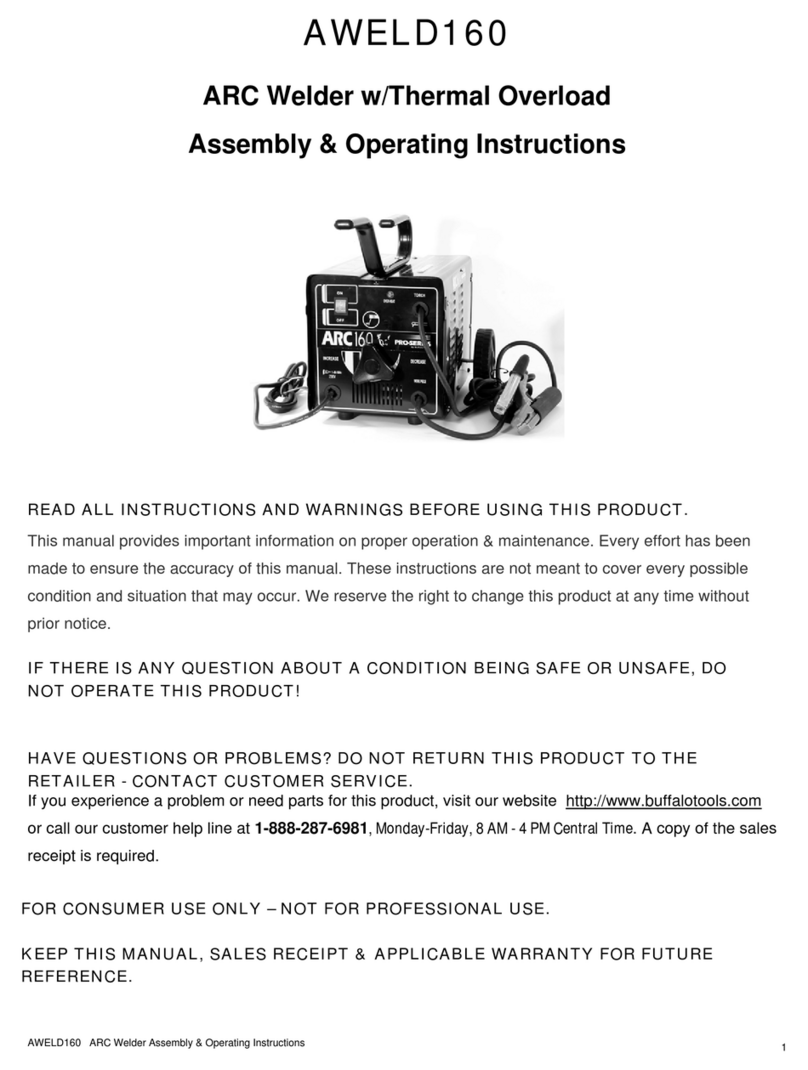
Buffalo Tools
Buffalo Tools AWELD160 Assembly & operating instructions
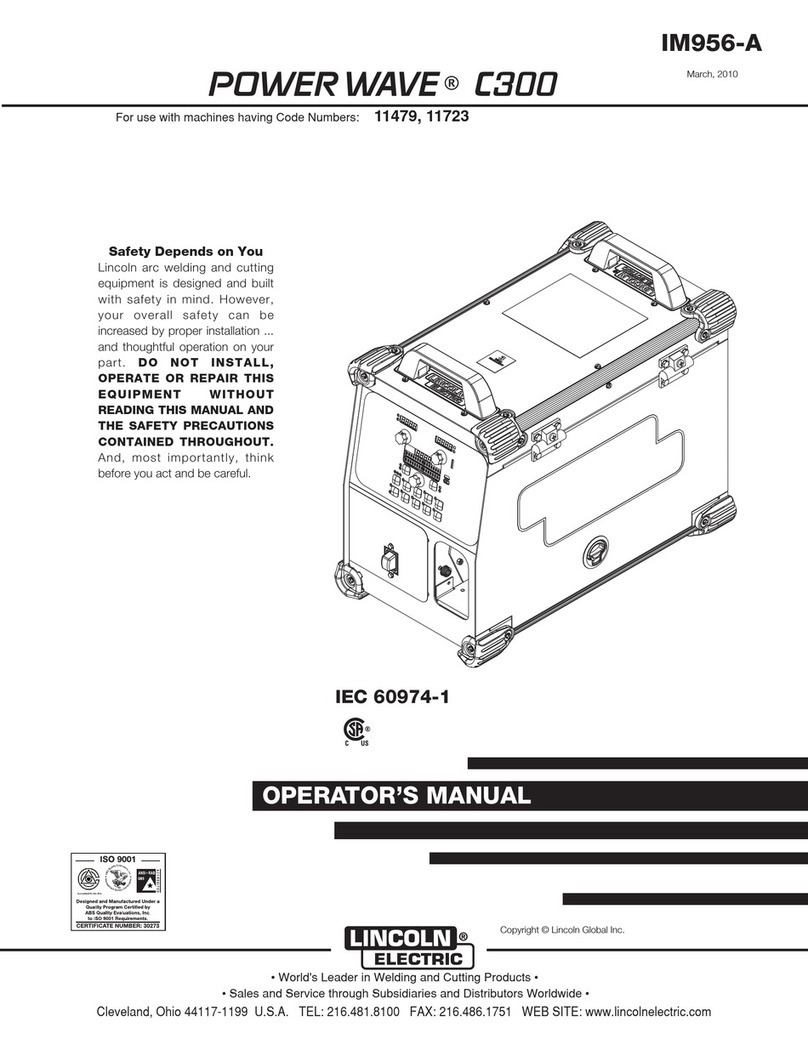
Lincoln Electric
Lincoln Electric POWER WAVE IM956-A Operator's manual

Miller
Miller S-44GL owner's manual
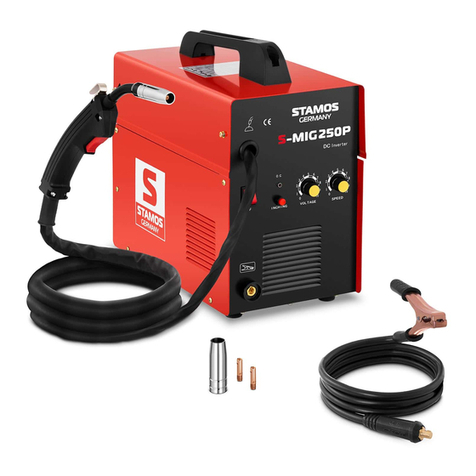
Expondo
Expondo STAMOS S-MIG 250P user manual
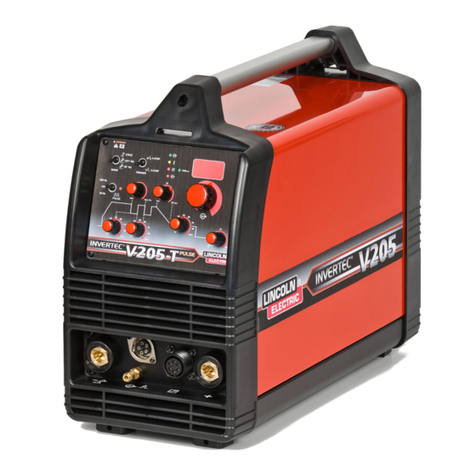
Lincoln Electric
Lincoln Electric INVERTEC V205-T AC/DC TIG Operator's manual

Lincoln Electric
Lincoln Electric PRO-CUT 125 IM491-B Operator's manual

Hyundai
Hyundai MIG-160 user manual
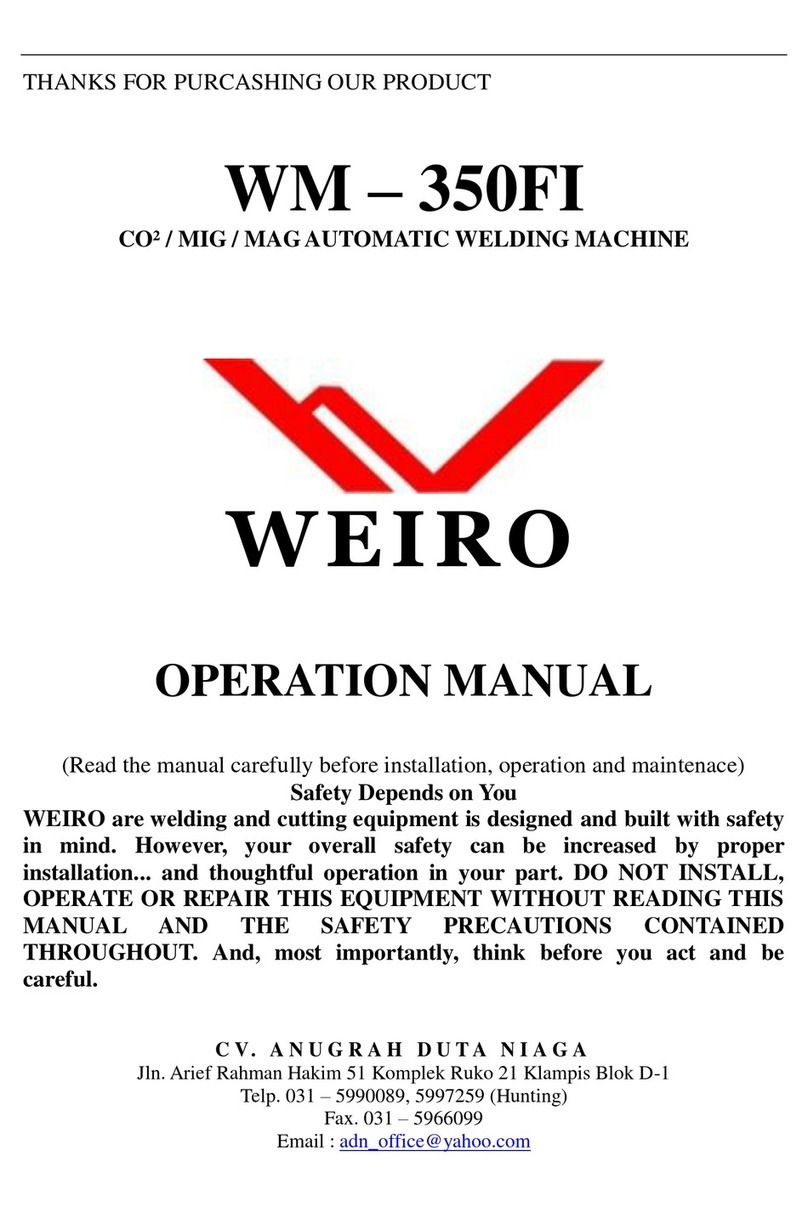
Weiro
Weiro WM250FI Operation manual
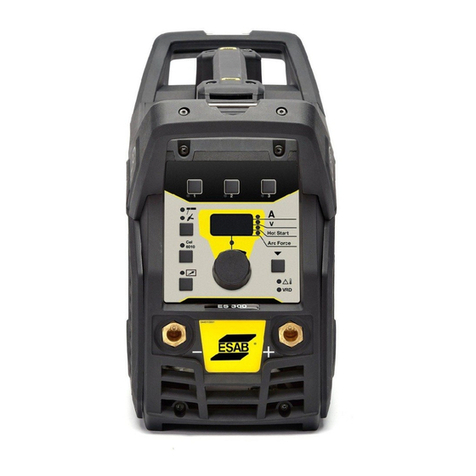
ESAB
ESAB Renegade ET 300i instruction manual

Lincoln Electric
Lincoln Electric Idealarc DC-600 operating manual

Lincoln Electric
Lincoln Electric POWER WAVE IM845-A Operator's manual
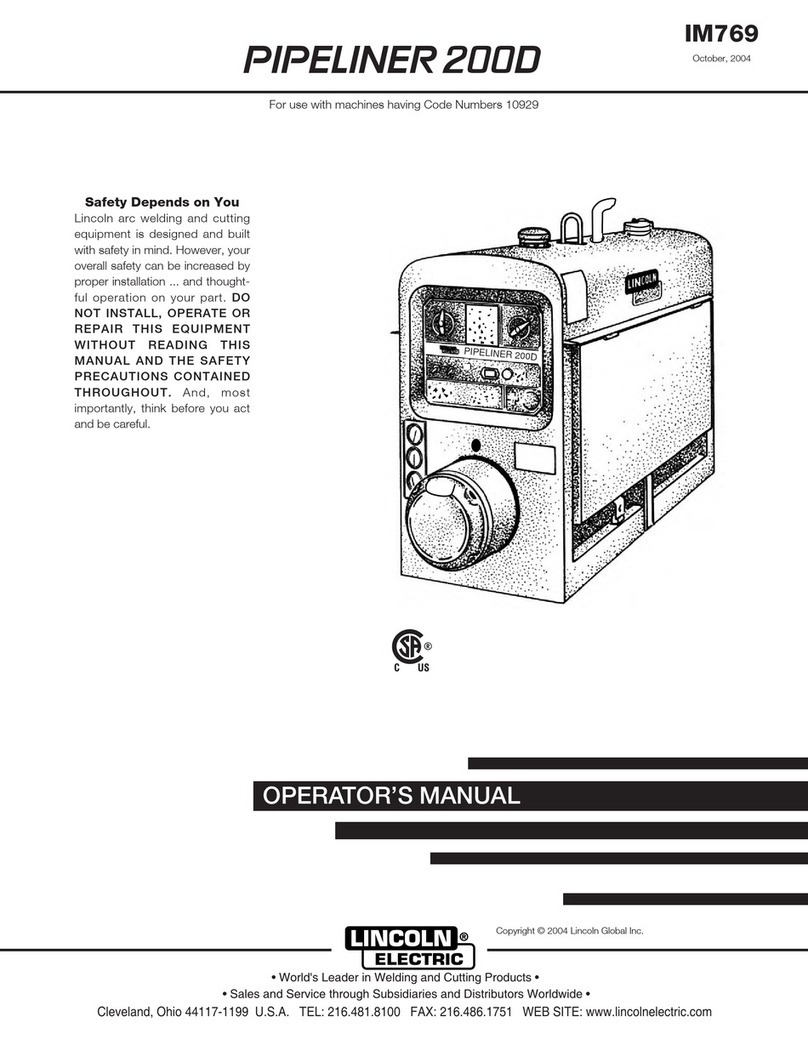
Lincoln Electric
Lincoln Electric PIPELINER IM769 Operator's manual

